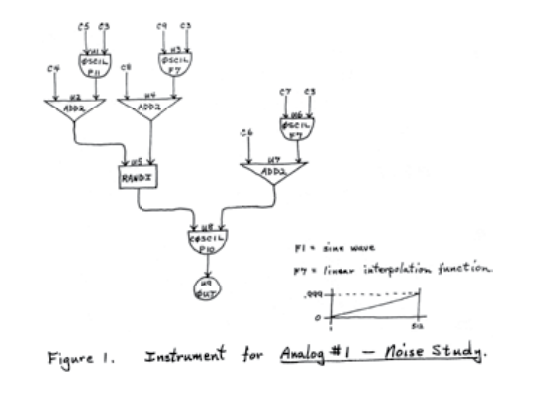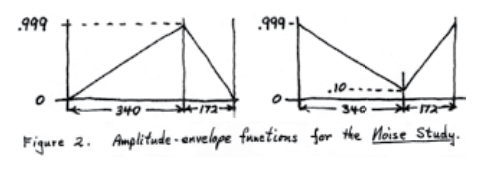created 2025-05-31, & modified, =this.modified
rel: Mainframe Experimentalism Silence - John Cage
Why I’m reading
Reading Mainframe Experimentalism I see a reference to Tenney’s masters thesis and want to learn more,
In his master’s thesis Meta/Hodos, Tenney proposed a theory that major works of 20th century western music could be understood as a product of a deeper reign of speech, not merely as an evolution of musical form.
What way does music relate to speech? I’ve always felt that when I’m playing guitar, there’s some connection to speech and that the sounds I am producing relate to communication/speech.
Tenney’s concern was not only “How do we hear music?” but also, “How might we hear and then make new music?”
He was by nature a scientific and exacting musical thinker, but he felt strongly he was not a scientist and at Bell Labs trusted the primacy of his listening experience over the data of the lab.
In Meta Hodos (MH) – we make perceptual distinctions by simple mechanisms of similarity/difference with a resultant mental representation of distance. Sound events are grouped in time using various types of similarity and temporal proximity, and this is done hierarchically.
“Avoidance of repetition,” became central to his work beginning in the 1980s.
Questions raised:
- the relationship of shape to state (“the exact pitch-relations may be altered without substantially alerting the ‘shape’ of the figure”)
- the theoretical, cultural, and perceptual bases of harmony
- the establishment of phenomenologically based parametric descriptors
Many of Tenney’s pieces after about 1980 were written with the assistance of his own computer programs.
His comments on exploration:
My intentions in this work were both exploratory and didactic. That is, I wanted to investigate the new harmonic resources that have become available through the concept of ‘harmonic space’ much more thoroughly than I had in any earlier work. At the same time I wanted to explore these harmonic resources within a formal context which would clearly demonstrate certain theoretical ideas and compositional methods already developed in my computer music of the early 1960s.
Meta / Hodos (1961)
One must be convinced of the infallibility of one’s own fantasy and one must believe in one’s own inspiration. Nevertheless, the desire for a conscious control of the new means and forms will arise in every artist’s mind, and he will wish to know consciously the laws and rules which govern the forms which he has conceived “as in a dream.” Strongly convincing as this dream may have been, the conviction that these new sounds obey the laws of nature and our manner of thinking … forces the composer along the road of exploration. Arnold Schoenberg, Style and Idea, 218
There was a time when theorists could refer to noises as “nonmusical sounds,” and this attitude still exists to some extent. But it is clearly unrealistic to make such a distinction now in the light of musical developments in the twentieth century. The elemental building materials of this music are no longer limited to “musical” tones but may include other, more complex sounds, which in an earlier music would have seldom functioned as elements, if they occurred at all.
No sound is time-independent in its acoustical features. Even the simplest tone has a characteristic time-envelope consisting of an attack, a steady-state, and decay in amplitude.
Definitions
- Clang in place of “sound”, “sound-configuration” or “musical idea.” A single aural gestalt.
- Element for subordinate parts of a clang.
- Sequence to define a larger unit, of a succession of clangs.
rel: Islands
The first phase of apprehension is a bounding line drawn about the object to be apprehended. An esthetic image is presented to us either in space or in time… . But temporal or spatial, the esthetic image is first luminously apprehended as self-bounded and self-contained upon the immeasurable background of space or time which is not it. You apprehend it as one thing. You see it as one whole. You apprehend its wholeness. James Joyce, A Portrait of the Artist as a Young Man
The Noise Study at Bell Labs


Cage
Cage on Satie
More and more it seems to me that relegating Satie to the position of having been very influential but in his own work finally unimportant is refusing to accept the challenge he so bravely gave us.
The material of music is sound and silence. Integrating these is composing.
The novelty of our work derives … from our having moved away from simply private human concerns toward the world of nature and society of which all of us are a part. Our intention is to affi rm this life, not to bring order out of chaos nor to suggest improvements in creation, but simply to wake up to the very life we’re living, which is so excellent once one gets one’s mind and one’s desires out of the way and lets it act of its own accord
Once a circle is drawn my necessity is to get outside of it… . No doubt there is a threshold in all matters, but once through the door—no need to stand there as though transfixed—the rules disappear. (1962)
My philosophy in a nutshell. Get out of whatever cage you happen to be in. (1972)